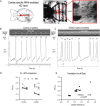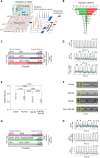Multiplatform modeling of atrial fibrillation identifies phospholamban as a central regulator of cardiac rhythm
- PMID: 37293707
- PMCID: PMC10387351
- DOI: 10.1242/dmm.049962
Multiplatform modeling of atrial fibrillation identifies phospholamban as a central regulator of cardiac rhythm
Abstract
Atrial fibrillation (AF) is a common and genetically inheritable form of cardiac arrhythmia; however, it is currently not known how these genetic predispositions contribute to the initiation and/or maintenance of AF-associated phenotypes. One major barrier to progress is the lack of experimental systems to investigate the effects of gene function on rhythm parameters in models with human atrial and whole-organ relevance. Here, we assembled a multi-model platform enabling high-throughput characterization of the effects of gene function on action potential duration and rhythm parameters using human induced pluripotent stem cell-derived atrial-like cardiomyocytes and a Drosophila heart model, and validation of the findings using computational models of human adult atrial myocytes and tissue. As proof of concept, we screened 20 AF-associated genes and identified phospholamban loss of function as a top conserved hit that shortens action potential duration and increases the incidence of arrhythmia phenotypes upon stress. Mechanistically, our study reveals that phospholamban regulates rhythm homeostasis by functionally interacting with L-type Ca2+ channels and NCX. In summary, our study illustrates how a multi-model system approach paves the way for the discovery and molecular delineation of gene regulatory networks controlling atrial rhythm with application to AF.
Keywords: Drosophila; Atrial fibrillation; Cardiac disease modeling; Computational modeling; High-throughput electrophysiology; Human iPSC-derived atrial-like cardiomyocytes; Single-cell resolution.
© 2023. Published by The Company of Biologists Ltd.
Conflict of interest statement
Competing interests The authors declare no competing or financial interests.
Figures







Similar articles
-
Atrial fibrillation-associated electrical remodelling in human induced pluripotent stem cell-derived atrial cardiomyocytes: a novel pathway for antiarrhythmic therapy development.Cardiovasc Res. 2023 Dec 19;119(16):2623-2637. doi: 10.1093/cvr/cvad143. Cardiovasc Res. 2023. PMID: 37677054 Free PMC article.
-
Human iPSC modelling of a familial form of atrial fibrillation reveals a gain of function of If and ICaL in patient-derived cardiomyocytes.Cardiovasc Res. 2020 May 1;116(6):1147-1160. doi: 10.1093/cvr/cvz217. Cardiovasc Res. 2020. PMID: 31504264 Free PMC article.
-
Cellular and molecular mechanisms of atrial arrhythmogenesis in patients with paroxysmal atrial fibrillation.Circulation. 2014 Jan 14;129(2):145-156. doi: 10.1161/CIRCULATIONAHA.113.006641. Epub 2013 Nov 18. Circulation. 2014. PMID: 24249718 Free PMC article.
-
Long Non-Coding RNAs in Atrial Fibrillation: Pluripotent Stem Cell-Derived Cardiomyocytes as a Model System.Int J Mol Sci. 2020 Jul 30;21(15):5424. doi: 10.3390/ijms21155424. Int J Mol Sci. 2020. PMID: 32751460 Free PMC article. Review.
-
Molecular and electrophysiological evidence for "remodeling" of the L-type Ca2+ channel in persistent atrial fibrillation in humans.Z Kardiol. 2000;89 Suppl 4:IV23-9. doi: 10.1007/s003920070060. Z Kardiol. 2000. PMID: 10810774 Review.
Cited by
-
The nutrient sensor CRTC and Sarcalumenin/thinman represent an alternate pathway in cardiac hypertrophy.Cell Rep. 2024 Aug 27;43(8):114549. doi: 10.1016/j.celrep.2024.114549. Epub 2024 Aug 1. Cell Rep. 2024. PMID: 39093699 Free PMC article.
-
Synergistic modelling of human disease.Dis Model Mech. 2024 Feb 1;17(2):dmm050755. doi: 10.1242/dmm.050755. Epub 2024 Feb 28. Dis Model Mech. 2024. PMID: 38415825 Free PMC article.
-
Lamin variants cause cardiac arrhythmogenicity in Drosophila.Dis Model Mech. 2025 Jul 1;18(7):dmm052424. doi: 10.1242/dmm.052424. Epub 2025 Jul 25. Dis Model Mech. 2025. PMID: 40605555 Free PMC article.
References
-
- Babu, G. J., Bhupathy, P., Timofeyev, V., Petrashevskaya, N. N., Reiser, P. J., Chiamvimonvat, N. and Periasamy, M. (2007). Ablation of sarcolipin enhances sarcoplasmic reticulum calcium transport and atrial contractility. Proc. Natl. Acad. Sci. USA 104, 17867-17872. 10.1073/pnas.0707722104 - DOI - PMC - PubMed
Publication types
MeSH terms
Substances
Grants and funding
LinkOut - more resources
Full Text Sources
Medical
Molecular Biology Databases
Research Materials
Miscellaneous

